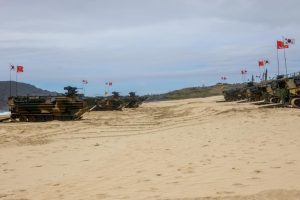With the strengthening of military cooperation between the United States and its allies in the region, North Korea again warned of taking corresponding measures. The statement came two weeks after a Foreign Ministry spokesperson reaffirmed Pyongyang’s “nuke to nuke” stance against the U.S.
“If it is the U.S. option to show its muscle and counter everything with muscle, the same is true of the DPRK’s option,” a spokesperson of the North’s Foreign Ministry said in the statement published in the North’s state media KCNA. (DPRK is an acronym of the North’s official name: Democratic People’s Republic of Korea.)
Citing the U.S. and South Korean militaries’ plan to hold extensive military exercises this year, North Korea accused Washington and Seoul of escalating the tensions on the Korean Peninsula. While stating that the North has refrained from “any special military action,” the spokesperson said the South Korea-U.S. combined military schemes “encroach upon the security interests of the DPRK.”
“The reality goes to clearly prove that the U.S. and South Korea are the arch criminals deliberately disrupting the peace and stability of the Korean Peninsula and the region,” the spokesperson said. “The DPRK should have to make reactions since the U.S. and South Korea openly revealed their dangerous attempt to gain a long-term military edge in the Korean Peninsula and the region.”
Despite its ballistic missile launches on the first day of this year, North Korea has halted its missile tests for the past few weeks. In a military parade held last week, however, North Korea demonstrated its advanced missile capabilities by showcasing dozens of its newest Hwasong-17 intercontinental ballistic missiles (ICBMs) and one suspected new solid fuel ICBM.
Apparently, Pyongyang has not yet kicked off extensive military activities as it did last year. As North Korea seems to be grappling with a serious food crisis, its leader Kim Jong Un may not be able to break the record of missile launches set last year due to a lack of financial resources. Although China and North Korea appear to have eased anti-pandemic measures, they have not yet entirely opened their border for bilateral trade.
The United States and South Korea have consistently expressed their willingness to provide humanitarian aid to North Korea, but Pyongyang has not responded to the offers.
On Thursday, the South Korean Defense Ministry published its newest white paper laying out its position on security issues and neighboring countries. In line with the hawkish approach of South Korea’s conservative President Yoon Suk-yeol, the white paper labeled North Korea “our enemy” for the first time in six years. Under President Moon Jae-in, Yoon’s predecessor, South Korea engaged in a peace process centered on dialogue with North Korea from 2017 to 2022. Moon’s Defense Ministry did not directly call North Korea an enemy, which brought criticism from the conservatives.
Under conservative and progressive administrations, North Korea had been labeled differently on the basis of the security environment. Considering that the 1950-1953 Korean War never formally ended, however, North Korea is clearly a main enemy of South Korea.
Emphasizing Pyongyang’s right of self-defense against the United States and South Korea, the North’s Foreign Ministry spokesperson explicitly warned about taking corresponding measures against the scheduled combined military drills.
“In case the U.S. and South Korea carry into practice their already-announced plan for military drills which the DPRK, with just apprehension and reason, regards as preparations for an aggression war, they will face unprecedently persistent and strong counteractions,” the spokesperson said.
South Korean and the U.S. militaries will hold a one-day table-top exercise, a computer simulation drill, at the Pentagon on February 22, according to media reports. The two sides will also hold the Freedom Shield exercise, an 11-day regular springtime joint military drill, next month.
Based on the North’s statement published on Friday, Pyongyang is likely to respond aggressively to the drills. In the past, North Korea’s “counteractions” have ranged from missile launches to artillery fire aimed into the ocean and fighter jets sent near the inter-Korean border.

































